
HOME
INTRO
SYMBOLS
ALMANAC
ECONOMY
GEOGRAPHY
STATE MAPS
PEOPLE
FORUM
NEWS
COOL SCHOOLS
STATE QUIZ
STATE LINKS
BOOK STORE
MARKETPLACE
NETSTATE.STORE
NETSTATE.MALL
GUESTBOOK
CONTACT US


Dbl click any word in
document for definition.
Texas State Health Nut
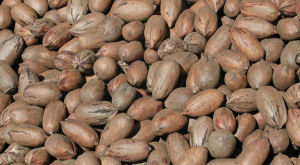
Texas State Health Nut: Pecan (nuts)
Brad Haire, University of Georgia, Bugwood.org
The pecan became the official health nut of the State of Texas when Governor Rick Perry signed Senate Concurrent Resolution No. 2 on June 16, 2001.
It may be somewhat surprising that it took so long to recognize the pecan as an official representative of the State of Texas. After all, the pecan tree was named the State Tree of Texas by the 36th Regular Session of the Texas Legislature and signed into law by Governor William Pettus Hobby in 1919.
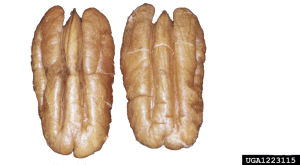
Texas State Health Nut: Pecan (meat of the nut)
Jerry A. Payne
USDA Agricultural Research Service, Bugwood.org
The upper photograph on the right shows the harvested pecan nuts. Within the shell of the pecan is the edible portion of the nut, the meat.
The lower photograph on the right shows the edible content of the pecan nut, the meat.
The pecan is native to North America. For thousands of years before the discovery of America, North American Indians were the only people who knew about pecans. No person from any other part of the world had ever seen this nut.
The pecan is much beloved in Texas. It's said that before he died in 1906, Governor James Hogg requested that a pecan tree be planted at his graveside and that the nuts from the tree should be given out to the people of Texas for planting so that Texas would become a land of trees.
NOTE: Governor Hogg is famously known for naming his daughter "Ima."
S.C.R. No. 2
SENATE CONCURRENT RESOLUTION
WHEREAS, The State of Texas traditionally has recognized a variety of official state symbols as tangible representations of the proud spirit and heritage of our state; and
WHEREAS, The bluebonnet, the lightning whelk, and the armadillo are examples of some natural specimens that serve to symbolize the great diversity of the Texas landscape, while the state dish, chili, fittingly represents another aspect of our shared culture as Texans; and
WHEREAS, One of the state's most universally enjoyed natural resources is the pecan; the nut of this majestic tree, which was deservedly named the state tree of Texas in 1919, is a delicious food product with considerable nutritional and health benefits; and
WHEREAS, Pecans contain protein, healthful oils, carbohydrates, fiber, iron, calcium, phosphorus, zinc, and potassium, as well as Vitamins A, B, C, and E and other antioxidants; scientific studies have also demonstrated that pecans can lower cholesterol, significantly contributing to improved cardiovascular health, while helping to reduce the risk of cancer; and
WHEREAS, A significant boon to the Lone Star State's economy, the pecan is grown commercially in more than 70 percent of the state's counties, and Texas provides over a quarter of the nation's pecan crop; and
WHEREAS, Nutritious and delicious, the pecan is an enduring and beloved aspect of the Texas landscape, and it is indeed appropriate that it be given special recognition at this time; now, therefore, be it
RESOLVED, That the 77th Legislature of the State of Texas hereby designate the pecan as the Official Health Nut of Texas.
Texas Law
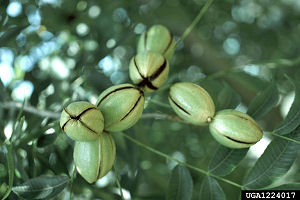
Texas State Health Nut: Pecan (nuts in husks ripening on tree)
Jerry A. Payne
USDA Agricultural Research Service, Bugwood.org
The pecan was named the official health nut of the State of Texas by Senate Concurrent Resolution and is not, therefore, listed in the Texas Statutes.
Interestingly, the State Tree of Texas was adopted by Senate Bill No. 317 in 1919 and, therefore, written into law.
Only a few of Texas' myriad symbols were actually adopted by an act of the legislature and written into the Texas Statutes.
Sources...
"Senate Concurrent Resolution No. 2." Texas Legislature Online. The Legislature of the State of Texas, 2001. Web. 19 Dec 2011.
"Texas Statutes:Government Code, Chapter 3101. State Symbols." Texas Legislature Online. The Legislature of the State of Texas, 2011. Web. 19 Dec 2011.
Shearer, Benjamin F. and Barbara S. State Names, Seals, Flags and Symbols: A Historical Guide Third Edition, Revised and Expanded. Westport, Conn: Greenwood Press, 3 Sub edition, 2001.
Additional Information
Pecan History: Bragg Pecans, Hondo, Texas.
Pecan: The University of Texas at Austin: Texas Beyond History, the virtual museum of Texas' cultural heritage.
Pecan Industry in Texas: The Handbook of Texas Online; The Texas State Historical Association.
Pecan (Carya illinoinensis): Texas AgriLife Extension Service: Texas Native Plants Database.
Pecan (Carya illinoinensis (Wangenh.) K. Koch: Tree Identification Fact Sheet from the Virginia Tech.
Plant Profile for Carya illinoinensis (Wangenh.) K. Koch (pecan): USDA, NRCS. 2011. The PLANTS Database (http://plants.usda.gov, 25 February 2012). National Plant Data Center, Baton Rouge, LA 70874-4490 USA.
Carya illinoinensis (Wangenh.) K. Koch (Pecan): United States Department of Agriculture: Forest Service: Agriculture Handbook 654: Silvics of North America.
Pecan: Photographs from CalPhotos, a project of the Biodiversity Sciences Technology group (BSCIT), part of the Berkeley Natural History Museums at UC, Berkley.
Carya illinoinensis (Wangenh.) K. Koch: A network connecting science with conservation - NatureServe Explorer: An Online Encyclopedia of Life.
Carya illinoinensis (Wangenh.) K. Koch: Integrated Taxonomic Information System (ITIS) Here you will find authoritative taxonomic information on plants, animals, fungi, and microbes of North America and the world.
San Saba History: Self-proclaimed "Pecan Capital of the World".
The Texas Pecan Board: Official website.
The Texas Pecan Growers Association: Official website.
The National Pecan Shellers Association: Official website.
State trees: Complete list of official state trees from NETSTATE.COM
More symbols & emblems: Complete list of official Texas state symbols from NETSTATE.COM.
Where to buy Texas pecans online
- Berdoll Pecan Farm: Cedar Creek, Texas.
- Circle H Orchards: Fair Oaks Ranch, Texas.
- Durham-Ellis Pecan Company: Comanche, Texas.
- Gilbert Pecan Co.: Santo, Texas
- Millican Pecan Co.: San Saba, Texas.
- Russell Pecan Orchards: Waco, Texas.
- Sorrells Farms: Comanche, Texas.
- Surratt Farms: Fabens, Texas.
- The Great San Saba River Pecan Company: San Saba, Texas.
- Montz Orchard: Charlie, Texas.
- West Pecan Farm: Wylie, Texas.
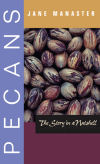
Pecans
Jane Manaster
Pecans: The Story in a Nutshell, by Jane Manaster. 120 pages. Publisher: Texas Tech University Press (January 15, 2008) Travel just about anywhere in the southern United States, and you will find pecan trees. The “nut too hard to crack by hand”—the derivation of the pecan’s Algonquian name—is one of the most successful native agricultural crops of North America. So popular are pecans that Thomas Jefferson once wrote home from Paris for a supply, while many people today consider their holidays incomplete without a pecan pie.
Jane Manaster’s Pecans, updated from its original 1994 publication, explores the natural history, cultivation, and uses of the pecan tree and nut.
Not forgetting the pecan’s popularity in candy and baked goods, Manaster includes nearly two dozen traditional and modern recipes for such delights as pralines, candied and roasted pecans, pecan pie, and pecan logs.
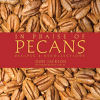
In Praise of Pecans
June Jackson
In Praise of Pecans: Recipes & Recollections , by June Jackson. 178 pages. Publisher: Bright Sky Press; First Printing edition (August 1, 2007) From the Introduction, which wistfully recalls Ms. Jackson's childhood spent picking out pecans for her mother's candymaking, to the candid discussion of the health aspects of pecans, the author evokes nostalgia and a desire to cook with pecans in order to improve our health.
Other than its delectable flavor, an important trait of the pecan is its adaptability. Jackson's compendium of more than 100 sumptuous recipes includes the use of pecans in all categories of cooking. The reader will enjoy encounters with Appetizers, Salads, "Sides," Entrees, Breads and Desserts, written in a clear, concise style. As a bonus, each recipe includes a little story or anecdote that enhances one's use of the recipes.

Pecans
Keith Courrege
Marcelle Bienvenu
Pecans: The Story in a Nutshell, by Keith Courrege and Marcelle Bienvenu. 128 pages. Publisher: Pelican Publishing (September 23, 2009) America’s most popular native nut, the pecan (“Crown Prince of the Nut Kingdom, God’s gift to the South”) offers a wealth of flavors and myriad culinary possibilities. This ultimate nut lover’s guide to the pecan presents more than three dozen recipes for dishes ranging from simple roasted pecans to Pecan Bread Dressing and decadent Pecan Truffles. The featured appetizers, main courses, side dishes, and desserts showcase the nut’s exceptional versatility.
While they are grown from Mexico to the Midwest, pecans have achieved their greatest celebrity in the American South, where vast pecan orchards provide the fodder for the holiday traditions of Pecan Pie and other comforting sweets. These classic dessert recipes provide a sweet finish to this collection’s appealing savory dishes, such as Cheesy Pecan Wafers, Pecan-Ginger Chicken with Pecan-Rice Pilaf, and Stuffed Pork Chops with Asparagus and Pecan Butter.

